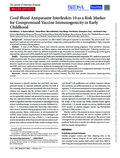Cord blood antiparasite interleukin 10 as a risk marker for compromised vaccine immunogenicity in early childhood
| dc.contributor.author | Malhotra, Indu | |
| dc.contributor.author | LaBeaud, A Desiree {et al} | |
| dc.date.accessioned | 2018-11-16T06:28:04Z | |
| dc.date.accessioned | 2020-02-07T10:19:44Z | |
| dc.date.available | 2018-11-16T06:28:04Z | |
| dc.date.available | 2020-02-07T10:19:44Z | |
| dc.date.issued | 2018-01 | |
| dc.identifier.uri | https://watermark.silverchair.com/jiy047.pdf?token=AQECAHi208BE49Ooan9kkhW_Ercy7Dm3ZL_9Cf3qfKAc485ysgAAAnMwggJvBgkqhkiG9w0BBwagggJgMIICXAIBADCCAlUGCSqGSIb3DQEHATAeBglghkgBZQMEAS4wEQQMH2vRSJcveugmWJfOAgEQgIICJnP_Rs4ZQDfrFXtJKEWnqNti_8ru7fU3yfIYpOjJnjn5LXEUXuuRgii0ZelKFvb4H-bvw65ybeIw2y3gkJcrriqM7JgQTqpgy4Esgnv_hFzS6m7lXKv0Hq6xclw319I-ulotsnMPcMnkP-JQilVQ6kGTR7KhV_zZpojkjg9rd8SreFDasbYB99gCvR7m56YrMPmscIm0iXMoN-Pz1oaYe1PKTWVNk-JJnooszwgOj6Ok9mfdYpbFZpzN3GPBlIBOlycYdKxOkbhXNbZqu1-0GOrRv3kIhymNzgLvhxateR1Rsa5FYhMONwwKz87_YCBeplt5oXLsJkMXqbxnfw86jpmjnfkQj1Npkaf2MGgG7nsS0Fbasq8VEoiyFhdUqRhV_Nd7hGg35DWUgj3lrPGTizGdDM8Fcw2nOTFwZMPfTyV_ds2FrtYiRAl0zW0oVoNnZd-MoM-KENAS1a5rc6vUB6UjHej9TT8wju2aa2OSRThUHNVeIIFoQY_Ad1aOjHLLffhqOQQ7nwyarmE0tfXX2H6PASvqbjQcVzXzPbUEdH8nvY-SaBD8xmCb1OwZ1KhrJVI9hVDpYhNEgnFH1POCRHV-d8RBJTY3ZyZsb1djn8Rb8yjnO3HNO7AKZzfsxUWyp1V4x1OYmhVRG8m09aiVn1s25uEQVBEiHh52VYVLN9MGHM9bXlPv42qSAQxuIY4pf4mHe7A29jN8Bd3uiKq-QTsxiKGWp6U | |
| dc.identifier.uri | http://repository.must.ac.ke/handle/123456789/1394 | |
| dc.description.abstract | Antenatal exposure to parasites can affect infants’ subsequent responses to vaccination. The present study investigated how maternal prenatal infections and newborns’ antiparasite cytokine profiles relate to immunoglobulin G (IgG) responses to standard vaccination during infancy. A total of 450 Kenyan women were tested for parasitic infections during pregnancy. Their newborns’ responses to Plasmodium falciparum, schistosome, and filaria antigens were assessed in cord blood lymphocytes. Following standard neonatal vaccination, this infant cohort was followed biannually to age 30 months for measurement of circulating IgG levels against Haemophilus influenzae b (Hib), diphtheria toxoid (DT), hepatitis B virus (HBV), and tetanus toxoid. Trajectories of postvaccination IgG levels were classified by functional principal component (PC) analysis to assess each child’s response profile. Two main components, PC1, reflecting height of response over time, and PC2, reflecting crossover from high to low responses or from low to high responses, were identified. Cord blood cytokine responses to schistosome and filarial antigens showed a significant association between augmented antihelminth interleukin 10 and reduced antibody levels, particularly to DT and HBV, and a more rapid postvaccination decline in circulating IgG levels against Hib, Antenatal sensitization to schistosomiasis or filariasis and related production of antiparasite interleukin 10 at birth are associated with reduced antivaccine IgG levels in infancy, with possibly impaired protection. | en_US |
| dc.language.iso | en | en_US |
| dc.publisher | The Journal of Infectious Diseases | en_US |
| dc.subject | Parasitic infection; prenatal exposure; cytokine balance; Th1-Th2; host parasite interaction; immunogenicity; vaccine | en_US |
| dc.title | Cord blood antiparasite interleukin 10 as a risk marker for compromised vaccine immunogenicity in early childhood | en_US |
| dc.type | Article | en_US |

